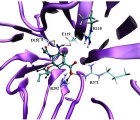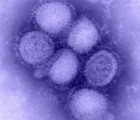Influenza vaccine seeds produced in chicken eggs are selected through HA and NA surface glycoproteins antigenicity, as well as through high replicative ability. Here we characterize the genetic content of recently used thirteen H3N2 influenza vaccine seeds. Interestingly, sequence analysis of the vaccine seeds shows reassortment events leading to PR8:H3N2 segment constellations, ranging from the 6:2 to 2:6 constellations. This study shows that the H3N2 PB1 is the most frequent internal segment incorporated in the tested vaccines seeds.
Seasonal influenza has considerable impact around the world, both economically and in mortality among risk groups. The long term patterns of disease are hard to capture with simple models, while the interplay of epidemiological processes with antigenic evolution makes detailed modelling difficult and computationally intensive. We identify a number of characteristic features of flu incidence time series in temperate regions, including ranges of annual attack rates and outbreak durations. We construct pseudo-likelihoods to capture these characteristic features and examine the ability of a collection of simple models to reproduce them under seasonal variation in transmission. Results indicate that an age-structured model with non-random mixing and co-circulating strains are both required to match time series data. The extent of matching behaviour also serves to define informative ranges for parameters governing essential dynamics. Our work gives estimates of the seasonal peak basic reproduction, R0, in the range 1.7-2.1, with the degree of seasonal variation having limited impact of these estimates. We find that it is only really possible to estimate a lower bound on the degree of seasonal variation in influenza transmissibility, namely that transmissibility in the low transmission season may be only 5-10% less than the peak value. These results give some insight into the extent to which transmissibility of the H1N1pdm pandemic virus may increase in Northern Hemisphere temperate countries in winter 2009. We find that the timescale for waning of immunity to current circulating seasonal influenza strain is between 4 and 8 years, consistent with studies of the antigenic variation of influenza, and that inter-subtype cross-immunity is restricted to low levels.
Authors Azra C Ghani 1 *, Marc Baguelin 2 *, Jamie T Griffin 1 *, Stefan Flasche 2,6 *, Richard Pebody 2 *, Albert Jan Van Hoek 2* , Simon Cauchemez 1 , Ian M Hall 3 , Christl A Donnelly 1 , Chris Robertson 4,6 , Michael T White 1 , Iain Barrass 3 […]
As the 2009 (H1N1) influenza A virus continues evolving, most mutations appear geographically and temporally confined. However, the latest surveillance data suggests emergence of a new prominent mutation, E391K, in the hemagglutinin (HA) that is globally on the rise. Interestingly, when modelled in the context of the available HA crystal structure, this mutation could alter salt bridge patterns and stability in a region of the HA oligomerization interface that is important for membrane fusion and also a known antigenic site. We discuss occurrence of HA-E391K in global surveillance data and associated clinical phenotypes from Singapore ranging from mostly mild to few severe symptoms, including sporadic vaccine failure. More clinical and experimental data are needed to determine if this mutation could alter the biology and fitness of the virus or if its increased occurrence is due to founder effects.
During a severe influenza pandemic individuals and families can, by following well-directed and scientifically-based measures, not only benefit themselves but also play an effective role in reducing transmission rates and the burden on public services. Such guidelines should be provided as clearly and comprehensively as possible by official sources. Here we examine the official recommendations issued by 10 countries to prepare their citizens for a severe pandemic. We have found the presence of hazardous guidelines – as the advice to personally visit a health center at the earliest symptoms – and shortage of practical advices for home isolation, business preparation and treatment to be widespread. Our review shows that, while many positive recommendations were provided, the set of recommendations issued by most countries was not comprehensive enough for severe influenza scenarios. This is a situation that needs revision
In fall 2009 the emergency department of a clinic in Greece with increased patient visits due to influenza-like illness observed a particular pattern in the complete blood count (CBC) of these patients. In 90% of all patients with probable influenza, lymphopenia and/or monocytosis were present. Relative lymphopenia with or without monocytosis appears to be a laboratory marker for H1N1 virus infection, a finding that could play a major role in early identifying and treating patients with new influenza A. A ratio of lymphocytes to monocytes below 2 is proposed as a screening tool for influenza infection instead of rapid tests.
The 3D-structure of the major surface viral antigen from the recent H1N1 pandemic influenza virus (A/Darwin/2001/2009) was determined to 2.8 Å resolution. The structure was used to analyze changes in the HA that have emerged during the first 11 months of the pandemic and have raised public health concerns. Receptor binding properties of this protein reveals a strict preference for human-type receptors.
The on-going debate about the health burden of the 2009 influenza pandemic and discussions about the usefulness of vaccine recommendations has been hampered by an absence of directly comparable measures of mortality impact. Here we set out to generate an “apples-to-apples” metric to compare pandemic and epidemic mortality. We estimated the mortality burden of the pandemic in the US using a methodology similar to that used to generate excess mortality burden for inter-pandemic influenza seasons. We also took into account the particularly young age distribution of deaths in the 2009 H1N1 pandemic, using the metric “Years of Life Lost” instead of numbers of deaths. Estimates are based on the timely pneumonia and influenza mortality surveillance data from 122 US cities, and the age distribution of laboratory-confirmed pandemic deaths, which has a mean of 37 years. We estimated that between 7,500 and 44,100 deaths are attributable to the A/H1N1 pandemic virus in the US during May-December 2009, and that between 334,000 and 1,973,000 years of life were lost. The range of years of life lost estimates includes in its lower part the impact of a typical influenza epidemic dominated by the more virulent A/H3N2 subtype, and the impact of the 1968 pandemic in its upper bound. We conclude that the 2009 A/H1N1 pandemic virus had a substantial health burden in the US over the first few months of circulation in terms of years of life lost, justifying the efforts to protect the population with vaccination programs. Analysis of historic records from three other pandemics over the last century suggests that the emerging pandemic virus will continue to circulate and cause excess mortality in unusually young populations for the next few years. Continuing surveillance for indicators of increased mortality is of key importance, as pandemics do not always cause the majority of associated deaths in the first season of circulation.
Using notification data, diffusion of pandemic human influenza A (H1N1) 2009 in Hong Kong was explored with geographic information system (GIS) methodology. Point data were displayed and then analysed with interpolation and the application of SaTScan™. Beginning from 6 initial foci, the spatial distribution has remained heterogeneous at the end of the first three months, with students functioning as the main disseminators. Our study showed that routinely collected surveillance data could be effectively used for describing the epidemic, which could support the development of interventions at local levels.
To estimate the magnitude of the risks associated with age, obesity, pregnancy and diabetes, we compared the prevalence of these conditions reported in hospitalized severe cases to that in the general population, during the 2009-2010 A(H1N1) pandemic flu in France. Pregnancy, obesity, heart failure and diabetes were risk factors for admission into an intensive care unit (OR=5.2 [95%CI 4.0-6.9], 3.8 [3.0-4.9], 3.3 [2.6-4.1] and 2.8 [2.3-3.4], respectively). Only heart failure, obesity, and diabetes were significantly associated with death (OR=6.9 [4.9-9.8], 3.6 [1.9-6.2], and 3.5 [2.5-5.1], respectively). Elderly adults were at lower risk of being admitted into an ICU, but at higher risk of death.




